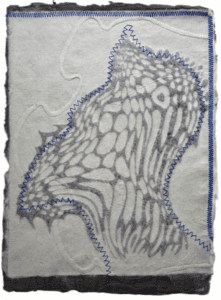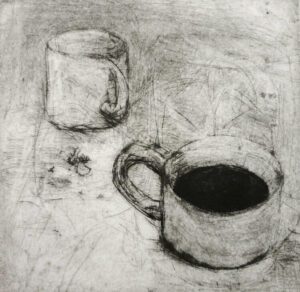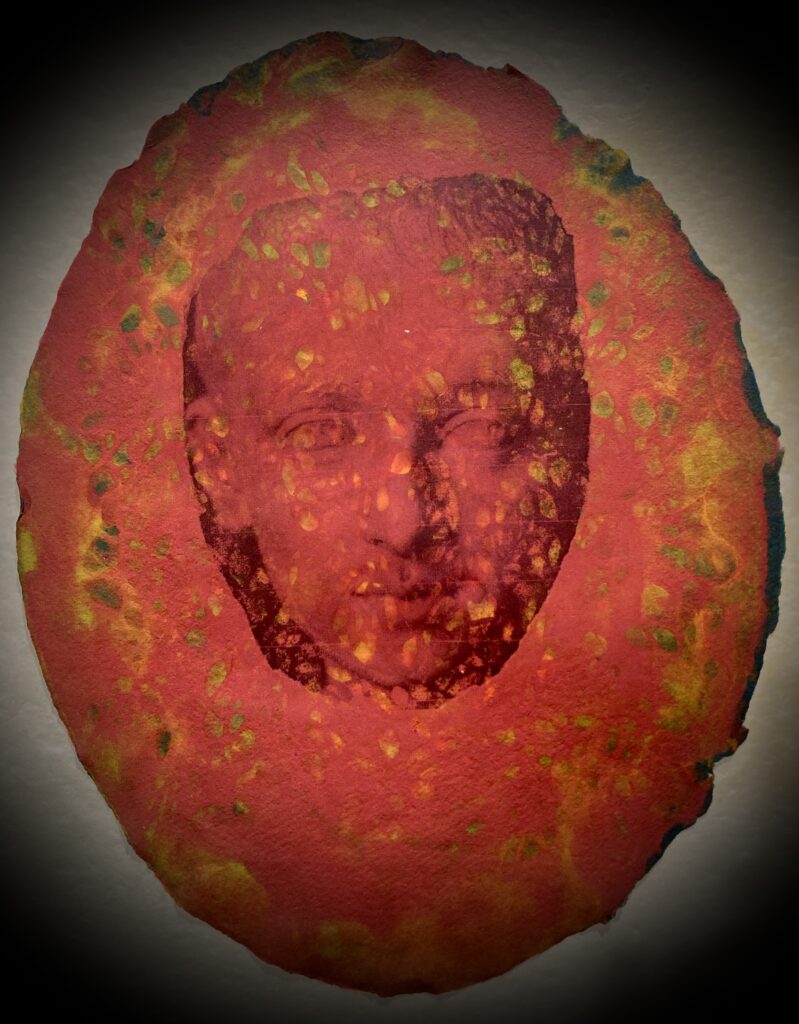This two-week workshop is divided between two interrelated disciplines: papermaking and printmaking.
In the first week, renowned Italian American paper artist and educator, Roberto Mannino, will introduce the basics of hand papermaking.
In the first week, participants will learn how to create unique papers from virgin, high quality fibers like cotton, linen, and abaca. Color laminations, transparencies and pulp painting effects will support your creativity in composing sheets up to A3 size. Since these papers will be internally sized, they will be rewetted to better retain inks and embossing under the etching press.
In the second week, several alternative printmaking methods will be introduced, with the central focus of first developing imagery with paper as the substrate, then further printing over it:
Two single-day excursions through the amazing countryside of Central Italy will enrich this experience:
In week-one, we will visit the city of Fabriano. In the medieval city, we will visit the Fabriano Paper and Watermark Museum, which houses a working medieval papermaking press. We will also visit the nearby Civic Art Collection, Bruno Molajoli, and the Istocarta, with the impressive Fedrigoni Paper arkive hosted in the Historical Milani Papermill.
In week-two, we will visit Perugia to visit an important collection of medieval manuscripts at the Bibilioteca Augusta and then we will visit the extraordinary, National Museum of Umbria, for a tour of the collections.
Participants in the program will be housed in the remarkably well-preserved Umbrian hill town of Monte Castello di Vibio. Your workshop package is all-inclusive, providing welcome and departure services and airport transfer from the Rome Fiumicino, Leonardo Da Vinci Airport (FCO). Aboard our comfortable private bus, single occupancy accommodations with shared bath (a wide range of upgrades with private bath are available), 3 meals per day Monday-Thursday, Prosecco brunch and dinner on Saturday and Sunday (no meals are served on Friday, our excursion day. Your workshop includes one excursion per week and many additional options are available on weekends for an additional fee. Of course, 24/7 access to facilities and 24/7 bi-lingual support are provided.
 The ancient Umbrian hill town of Monte Castello di Vibio is the perfect place to discover the art of drypoint printmaking and learn to pull hand-wiped prints in this 2-week intaglio workshop with master printer Ian Jackson.
The ancient Umbrian hill town of Monte Castello di Vibio is the perfect place to discover the art of drypoint printmaking and learn to pull hand-wiped prints in this 2-week intaglio workshop with master printer Ian Jackson.
Intaglio (from the Italian ‘tagliare,’ meaning to carve or cut), is the term encompassing the multitude of printmaking techniques where a mark incised in a plate holds ink while the surface is wiped clean before printing. Drypoint is the most direct of these techniques, enabling artists to draw directly onto copper with sharp tools, raising ink-holding burrs that when delicately wiped and printed produce prints cherished for their uniquely soft-edged lines and velvety-rich tones.
Participants will learn the drypoint technique and the printing process and will have ample time to draw. The village offers no shortage of drawing inspiration from the dazzling Umbrian landscape to the medieval stone architecture, the still studio moments or the figures all around.
Excursions to Florence and to Deruta/Perugia will supplement the curriculum with tours of masterworks in collections of those cities. In Florence, the group will visit the print collection of the famed Uffizi Museum. Here, the new Study Center provides special access to our participants and allows them to view prints by some of the greatest masters of the medium. In Peruigia, te group will tour the collections of the National Gallery of Umbria and the Biblioteca Augusta for a special access tour of their medieval illuminated manuscripts and prints.
 Through out their stay, participants will be housed in the remarkably well-preserved Umbrian hill town of Monte Castello di Vibio. Your workshop package is all-inclusive, providing welcome and departure services and airport transfer from the Rome Fiumicino, Leonardo Da Vinci Airport (FCO). Aboard our comfortable private bus, single occupancy accommodations with shared bath (a wide range of upgrades with private bath are available), 3 meals per day Monday-Thursday, Prosecco brunch and dinner on Saturday and Sunday (no meals are served on Friday, our excursion day. Your workshop includes one excursion per week and many additional options are available on weekends for an additional fee. Of course, 24/7 access to facilities and 24/7 bi-lingual support are provided.
Through out their stay, participants will be housed in the remarkably well-preserved Umbrian hill town of Monte Castello di Vibio. Your workshop package is all-inclusive, providing welcome and departure services and airport transfer from the Rome Fiumicino, Leonardo Da Vinci Airport (FCO). Aboard our comfortable private bus, single occupancy accommodations with shared bath (a wide range of upgrades with private bath are available), 3 meals per day Monday-Thursday, Prosecco brunch and dinner on Saturday and Sunday (no meals are served on Friday, our excursion day. Your workshop includes one excursion per week and many additional options are available on weekends for an additional fee. Of course, 24/7 access to facilities and 24/7 bi-lingual support are provided.
The workshop is suitable for artists and printmakers of all experience levels. All materials, except paper (available for purchase at the ICA Art Supply Store) will be provided.
Paper is an amazing material with the potential to be structurally strong or flexible and soft, opaque or translucent, a base for drawings and paintings, a sculptural form or bound into books for writing and illustrations.
In this workshop we will explore the potential of paper as a basic material and as a medium for artistic pursuits. This two-week event will be led by internationally known instructors Amanda Degener, founder of Cave Paper; Carol Barton of Popular Kinetics; Denise Carbone from the University of the Arts and Tom Balbo of Tom Balbo Galleries. The Workshop will also feature a two-day pulp-painting component, led by Visiting Artist, Roberto Mannino.
Students will be signing up for all below components, with 12 hours of instruction in each area: hand papermaking, pulp paper painting and marbling, sewn bookbindings, and designing pop-ups. The workshop will also include field trips to the Fabriano Paper Mill and to the city of Florence, along with several other excursion stops. In addition, Amanda will be offering optional morning Tai Chi sessions. This is an ideal session for teachers, graphic designers, creative artists, and anyone who likes to play with paper. No prior experience is necessary; all skill levels are welcome.
From Turkey to America: Traditional and Experimental Marbling Techniques
With Tom Balbo
Participant's, will learn to mix paints and prepare paper, and to familiarize themselves with traditional patterns. These patterns derive from the Turkish “ gel-get “ pattern. Day two students will have the option to continue pattern work, experiment with freeform, stencil, and floral patterns. The use of mores will be an added as additional pattern work and incorporated in to a variety of experimental practices. The use of handmade paper and older papers that will not need alum sizing will also be made available. Participants should plan to purchase or bring tube to handle 18”x 24” papers and smaller sizes as well. Also any papers one wants to experiment with are welcomed.
Pop-Up Paper Structures
With Carol Barton
A special kind of creative magic awaits you in this workshop. You will learn basic on-the-fold pop-up structures, then progress through a series of more complicated three-dimensional glued constructions. Props, platforms, spirals, V-folds and straddle pop-ups will be covered. Emphasis will on developing an understanding of the simple mechanics involved in this art of “paper engineering.” A public slide show on the history of pop-up and movable books will be presented for students and town residents. This is an ideal class for artists, teachers, graphic designers, and anyone who loves to play with paper. No prerequisite.
 Tailored to fit: A desirable pamphlet for everyday use
Tailored to fit: A desirable pamphlet for everyday use
With Denise Carbone
In the fascinating realm of book arts, the traditional technique of bookbinding extends to encompass a variety of forms, including the creation of detailed bookbinding pamphlets, which serve as both notebooks and showcases the craft. Among the myriad styles, the single section German case binding stands out for its durability and elegance. Truly the perfect companion.
The 2-section soft cover variant, which combines flexibility with the classic aesthetic of hardcover books uses Cave paper for its cover and parchment for the spine. The 2-section pamphlet sewing attaches the sections with a pocket inside the cover.
Another innovative approach within book arts is the 3-section exposed sewing method, which not only secures pages with precision but also turns the stitching into a decorative element, highlighting the craftsmanship involved. This technique lends a unique character to each piece, inviting readers and collectors to appreciate the structural beauty of the book as an object. As these innovative practices continue to evolve, they enrich the world of book arts, blending tradition with creativity to produce works that are not just to be handled, but admired and treasured.
With Amanda Degener
During this two day workshop participants will make their own small handmade paper sculptures/lamps that incorporate light. We will have paper available so you can make your own paper choices and students will also sheet form Japanese style paper which is incorrectly called rice paper. We will go through the process of cooking, beating, and coloring what was once a kozo plant. Some of the techniques include tamping wet paper onto a mold or balloon which is like a sophisticated papier mâché. We will also make a simplified version of the Japanese collapsible spherical chochin lantern. Translucency will be considered and both natural and electric light can be incorporated into your work
 Painting with Linen Pulp With Roberto Mannino
Painting with Linen Pulp With Roberto Mannino
This two- day workshop will explore the fascinating possibilities of painting with paper pulp with a master of the medium, renowned Rome-based artist, Roberto Mannino.
We will explore the various aspects and possibilities of creating images using intensively pigmented pulp as a painting method. By combining pulp, water and flocculent in different ratio, participants will be able to combine sharp edges and blurred transparent layers.
Staring with standard papermaking sheet-forming with moulds and further testing with the use of deckle boxes, this workshop will introduce various techniques of multilayering finely beaten and colored pulp to a wet sheet using multiple kind of stencils, grids, squeeze bottles and eyedroppers. Working with handmade paper in its wet state will allow for further image manipulation by transferring inkjet prints and water solvable drawings on the moist sheet before drying.
Origami is the Japanese art of paper folding, marrying the arts with mathematics to create some truly complex and stunning structures. This summer course will primarily focus on art, using mathematical techniques to design your own origami. For USAO students, this course counts as an Artistic Expression course.
For more information on mathematics role in origami, click here.
For more information, contact us.
Where we live, visit, and create can be a great source of inspiration. In this workshop we will view our surroundings with visitor’s eyes and make note of the details that appeal to us and draw us in. We will translate those details, from mundane to exceptional, (a window, archway, flower, fruit, bottle, hat, etc.) into simple repeatable images using stencils, block prints, and image transfers. You will learn surface design techniques including printing, stitching, mending, embroidery, collage, and dyeing and painting with local earth pigments, etc. Our richly layered papers and fabric will be made into books, scrolls, wall pieces, vessels, bags, and objects. Jody will teach students a number of bookmaking and paper structure techniques as well as how to construct items out of fabric including books, bags, pockets, vessels and other objects. By the end of the workshop each of us will have a different but cohesive collection of richly layered items communicating a sense of place that will be arranged into personal installations.
Field trips will serve as source material and inspiration gathering expeditions as well as personal enrichment. Trips will include visits to Florence and Rome.
For more information, contact us.
Master Printer Ian Jackson leads a 2-week intaglio workshop at the International Center for the Arts.
Intaglio (from the Italian tagliare, meaning to carve or cut), is the term encompassing the multitude of printmaking techniques where a mark incised in a plate holds ink while the surface is wiped clean before printing.
Drawing directly into copper plates by raising a metal burr with sharp implements, participants will learn the exquisite craft of drypoint and produce hand-wiped prints of original drawings.
Drypoint is uniquely prized among artists and collectors for its velvety-rich line quality and sfumato-like tonality, achievable only through careful scraping and polishing.
Within the walls of the medieval village of Monte Castello di Vibio high above the countryside, artists will find no shortage of inspiration. One wakes up in the morning, takes a step from their doorway, and is immediately overcome by the impulse to draw everything within sight: hillsides dotted in olive groves smeared in dazzling Umbrian sunlight; thick stone architecture casting long shadows; a tranquil studio filled with diffuse natural light, waiting to be occupied.
Over the course of the 2-week workshop, participants will learn every step of the drypoint printing process while refining their own drawings through the frequent repetition of proofing, critiquing, and editing, culminating in the production of their own edition and a group show.
For more information, contact us.
Working on heavy grade watercolor paper, using ink and watercolor, students will employ geometry, line, shape and form to create 2 non-objective paintings.
We will research designs and interpret them for our various individual projects during the second week. Please feel free to bring your design ideas and other inspirational materials to adapt as well.
As inspiration, we will be looking at historic designs found in art and architecture during our trips to both Florence and Rome.
We will be using a variety of techniques gained from studies in both European and Indian processes (including; color filling, line and design work, burnishing, washing, sanding and waxing),
Students will aim to create a harmonious balance from a mix of structure and improvisation by daily:
Meditation— finding thoughtless awareness through the use of affirmations, self awareness and inner peace.
Yoga— basic Hatha yoga practice allowing the student to slow down, tune into oneself and ones breathing and let the body guide you through simple movements such as Surya Namaskar.
Mindful observation 1— sit in silence drawing an object for three minutes, at the end of this time restart, drawing the same object again. 30 minutes.
Mindful observation 2— using the senses to raise awareness and explore imagination through the use of taste, touch and sound.
The course will be run with the help of Danish artist and assistant Emma Holm.
For more information, contact us.